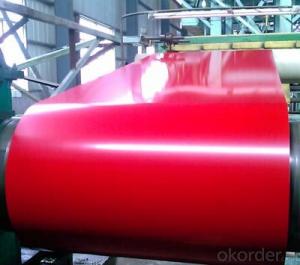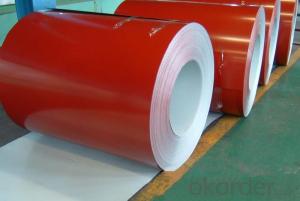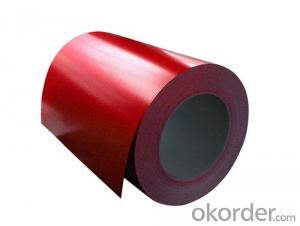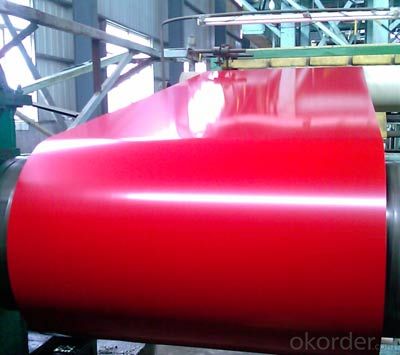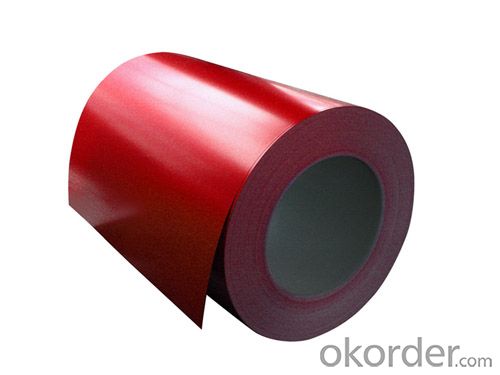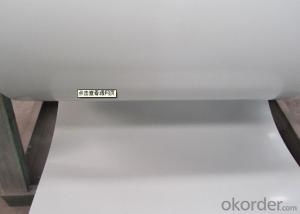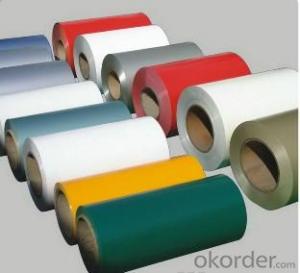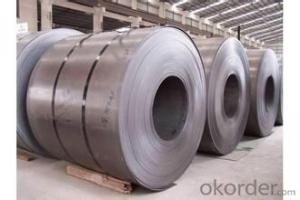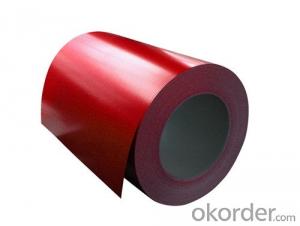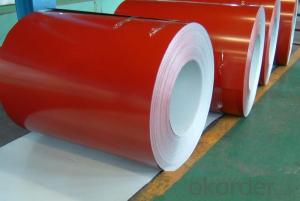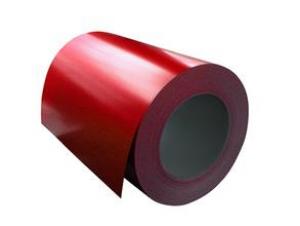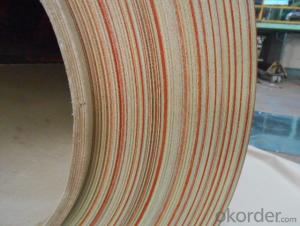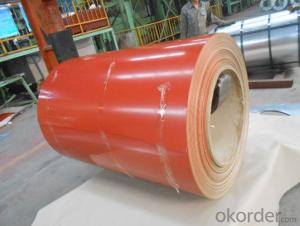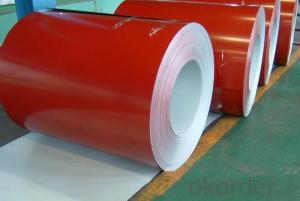Pre-Painted Galvanized/Aluzinc Steel Sheet in Coils Red Color in high quality
- Loading Port:
- Shanghai
- Payment Terms:
- TT OR LC
- Min Order Qty:
- 500 m.t.
- Supply Capability:
- 10000 m.t./month
OKorder Service Pledge
OKorder Financial Service
You Might Also Like
1. Pre-Painted GI/GL Steel Coil Description:
With GI as base material, after pretreatment (degrease and chemical treatment ) and liquid dope with several layers of color, then after firing and cooling, finally the plate steel is called pre-painted galvanized (aluzinc) steel. Pre-painted galvanized steel is good capable of decoration, molding, corrosion resistance. It generally displays superior workability, durability and weather resistance.
2.Main Features of the Pre-Painted GI/GL Steel Coil:
• Excellent process capability
• Smooth and flat surface
• Workability, durability
• Excellent heat resistance performance
• High strength
• Good formability
• Good visual effect
3.Pre-Painted GI/GL Steel Coil Images
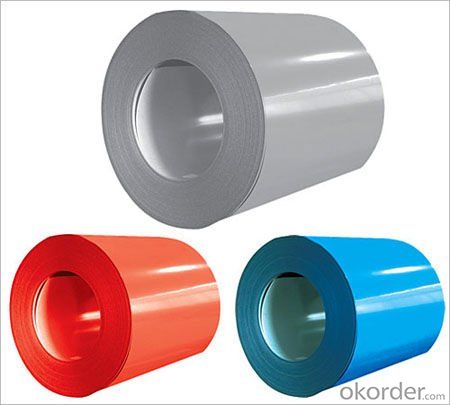
4.Pre-Painted GI/GL Steel Coil Specification
Standard: AISI, ASTM, BS, DIN, GB, JIS
Grade: DX51D, DX52D
Thickness: 0.17-2.0mm
Brand Name: KMRLON
Model Number: coil
Type: Steel Coil
Technique: Cold Rolled
Surface Treatment: Coated
Application: Boiler Plate
Special Use: High-strength Steel Plate
Width: 20-1250mm
Length: customized
commoidty: pre-painted galvanized steel coil
Thickness: 0.13-4.0mm
width: 20-1250mm
zinc coating: 40-180g/m2
printing thickness: top side: 20+/-5 microns, back side: 5-7 microns
color: all RAL color
surface treatment: color coated
coil weight: 4-7 tons
coil ID: 508/610mm
packaging: standard seaworthy packing
5.FAQ of Pre-Painted GI/GL Steel Coil
1. What’s the application of this product?
Roof, roof structure, surface sheet of balcony, frame of window, etc.
2. What’s the brand of the paint?
We use the best brand of all of the word—AKZO.
3. How to guarantee the quality of the products?
We have established the international advanced quality management system,every link from raw material to final product we have strict quality test;We resolutely put an end to unqualified products flowing into the market. At the same time, we will provide necessary follow-up service assurance.
4. How long can we receive the product after purchase?
Usually within thirty working days after receiving buyer’s advance payment or LC. We will arrange the factory manufacturing as soon as possible. The cargo readiness usually takes 15-25 days, but the shipment will depend on the vessel situation.
- Q: in a lab at school we did heat treatment of steelwhat are the possible phases present in the steel sample in as-received, as-quenched and as-tempered conditions? specifically when is it ferrite, austenite and pearliteis the steel originally in the ferrite phase? then when headed turns into austenite and when quenched martensite is formed and when tempered cermentite is formed...........where is pearlite involved and am i correct about the ferrite?
- hey from what i learned in uni last sem, steel is originally ferrite form at first at room conditions. it will undergo poly morphic transformation to become FCC structure austenite form at 912 degree celcius. under conditions, it can become pearlite (which is a combination of ferrite and cementite) or bainitie( a finer form of pearlite). queching conditions to room temperature will form martensite which is the strongest but brittle steel form. tempered cementite is formed when we quench it and then raise temperatures before sir cooling. hope it helps, pls vote me best answer is i deserve it. thanks
- Q: How are steel coils priced and traded in the market?
- Steel coils in the market are priced and traded based on a variety of factors. The primary determinant is the current dynamics of supply and demand in the steel industry. When demand for steel coils is high, prices tend to increase, and vice versa. The cost of raw materials, such as iron ore and coal, is another crucial factor in determining the price of steel coils. Fluctuations in the prices of these materials can directly impact the pricing of steel coils. Furthermore, the price of steel coils is influenced by their quality and specifications. Coils with desirable characteristics, such as strength, corrosion resistance, or surface finish, may command a higher price in the market. Steel coils are traded through different platforms, including physical exchanges, futures contracts, and over-the-counter (OTC) markets. Physical exchanges allow buyers and sellers to trade steel coils by exchanging physical deliveries. Futures contracts, on the other hand, enable traders to buy or sell steel coils at a predetermined price and future date, providing a way to hedge against price fluctuations. The OTC market provides an alternative avenue for trading steel coils, where buyers and sellers negotiate and agree on prices directly without involving a formal exchange. This allows for flexibility and customization in trading, catering to specific requirements. In conclusion, the pricing and trading of steel coils in the market are influenced by factors such as demand and supply dynamics, raw material costs, quality specifications, and the availability of different trading platforms. It is a complex process that requires careful consideration of various factors to determine fair prices and facilitate efficient trading.
- Q: How are steel coils used in the manufacturing of steering systems?
- Steel coils are used in the manufacturing of steering systems as they are shaped and formed into various components such as shafts, gears, and brackets. These components are crucial for ensuring the stability, strength, and functionality of the steering system.
- Q: Which one has more electrical resistivity? Wood or steel? And why?I know that the resistivity depends on the material of the conductor, but i want a perfect explaination please.Thnx in advance :)
- Steel Resistivity
- Q: How do steel coils contribute to the manufacturing of household appliances?
- Steel coils contribute to the manufacturing of household appliances by providing a durable and versatile material for various components. These coils are used to create the outer casings, frames, and structural parts of appliances like refrigerators, washing machines, and dishwashers. The strength and flexibility of steel coils ensure the longevity and stability of these appliances, while also enabling manufacturers to create sleek and attractive designs.
- Q: What are the different methods of engraving steel coils?
- Engraving steel coils can be accomplished through various techniques, each presenting its own advantages and applications. Some commonly utilized methods include: 1. Chemical Etching: This involves the application of a chemical solution onto the steel coil's surface, selectively eradicating metal to achieve the desired design. Chemical etching boasts exceptional precision, enabling the creation of intricate patterns and fine details. It is often employed for decorative purposes, such as logos or patterns on steel coils. 2. Laser Engraving: By employing a high-powered laser beam, laser engraving eradicates the top layer of the steel coil, resulting in a permanent mark. This method offers superior precision and accommodates complex designs, logos, or text. Laser engraving is frequently employed for branding purposes or to add identification marks to steel coils. 3. Mechanical Engraving: Mechanical engraving utilizes a cutting tool or diamond-tipped stylus to physically eliminate metal from the steel coil's surface. This technique is renowned for its durability and versatility, capable of creating deep and long-lasting engravings. Mechanical engraving is commonly used for industrial applications, such as adding serial numbers, part codes, or other identification marks to steel coils. 4. Electrochemical Etching: Electrochemical etching, also known as electrolytic etching, employs an electric current to selectively dissolve the metal surface of the steel coil. This technique is frequently employed for marking and branding purposes, as it produces high-quality and permanent engravings. Industries requiring precision and durability, like aerospace or automotive manufacturing, often utilize electrochemical etching. 5. Inkjet Printing: Although not technically engraving, inkjet printing allows for the addition of patterns or designs onto steel coils. This process involves utilizing specialized inks and a digital printing system to directly apply the desired design onto the coil's surface. Inkjet printing is versatile, cost-effective, and provides high-resolution prints, making it suitable for various applications, including decorative or branding purposes. In conclusion, the range of methods available for engraving steel coils offers a multitude of options for creating permanent markings, logos, or patterns. The choice of method depends on factors such as desired precision, durability requirements, and the specific application for the steel coil.
- Q: which type of carbon steel does not have manganese
- None. Mn is a trace impurity in all steels, if you look carefully enough. If you want to find a steel where Mn is not intentionally added, start looking at the alloy composition specifications, there are hundreds of steels. Why are you worried about Mn? Mn is typically added to steels for a very good reason.
- Q: What is the most common bullet resistant steel that is used, can certain bullets just not be stopped, also what type of glass is bullet resistant or is that special made.
- If you want to stop a bullet with steel, you need strength, ductility, thickness, or some combination of these. The higher the strength, the greater the force the steel can withstand before it breaks. The higher the ductility, the more the steel can deform before it breaks. Unfortunately, when you increase the strength, the ductility usually goes down. That's why you may need substantial thickness. 1 centimeter of precipitation-hardened stainless steel (15-5 or 17-4, for example) is probably enough to stop most handgun bullets.
- Q: How are steel coils used in the manufacturing of tubes?
- Steel coils are used in the manufacturing of tubes by being unwound and fed through a tube mill where they are shaped and welded together to form seamless or welded tubes.
- Q: What are the dimensions of steel coils used in the oil and gas industry?
- The dimensions of steel coils in the oil and gas industry can differ based on the specific application and needs. Nevertheless, there are commonly used dimensions. Steel coils in the oil and gas industry typically possess a width that ranges from 600mm to 2000mm. The coil's outer diameter can vary from 800mm to 2200mm, while the inner diameter can range from 508mm to 610mm. The coil's weight can also vary, ranging from a few tons to several tens of tons. These dimensions are tailored to fulfill the requirements of diverse processes in the oil and gas industry, including pipe manufacturing, storage tank fabrication, and offshore platform construction. It is important to emphasize that these dimensions are not fixed and can be customized to meet the specific demands of each project.
Send your message to us
Pre-Painted Galvanized/Aluzinc Steel Sheet in Coils Red Color in high quality
- Loading Port:
- Shanghai
- Payment Terms:
- TT OR LC
- Min Order Qty:
- 500 m.t.
- Supply Capability:
- 10000 m.t./month
OKorder Service Pledge
OKorder Financial Service
Similar products
Hot products
Hot Searches
Related keywords
